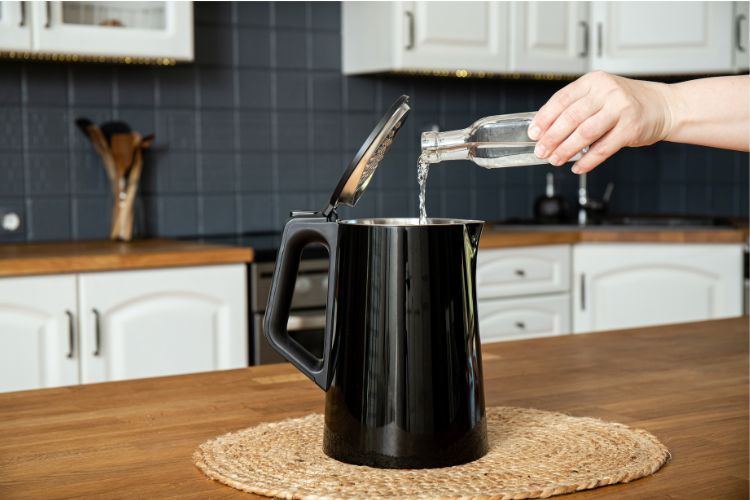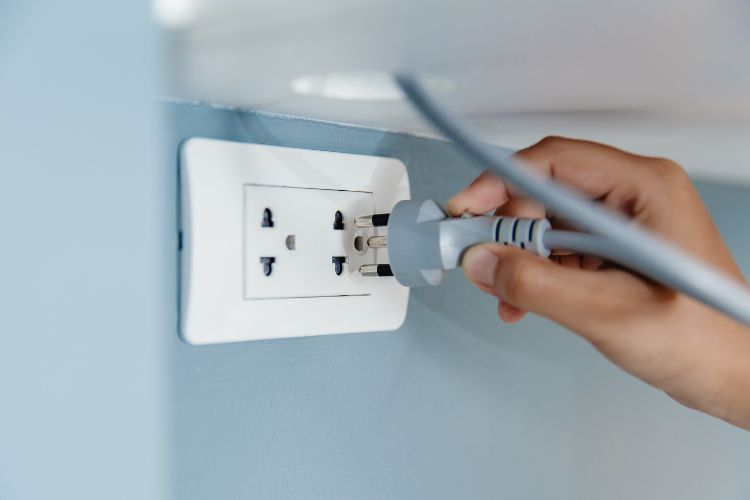When you rely on a cup of coffee or tea to jumpstart your day, a kettle that refuses to heat up can be a real buzzkill.
Fellow’s electric pour-over kettle, especially the Stagg EKG, is a favorite among coffee enthusiasts for its variable temperature control and precision.
However, even the best appliances can face issues. In this article, we’ll explore common problems and troubleshooting steps for your Fellow kettle.
Why Is the Fellow Kettle Not Heating?
There are many reasons behind this, including faulty chords, mains, dirty parts, and dry boiling. We’ll explain each in detail, but you should understand that not every problem can be fixed at home.

Sometimes there’s no way around taking your Fellow kettle to be fixed.
That being said, here’s why your kettle may not be working:
1. There’s a Problem With the Power Cord
A faulty power cord is a common culprit when your kettle refuses to heat up. Despite their sturdiness, power cords can suffer from damage due to sharp bending or short circuits. If you suspect the power cord is the issue:
Inspect the power cord for signs of wear and tear, such as bends or broken plastic casing. If you detect any damage, discontinue use immediately and consider repairing or replacing it.
2. There Could Be an Issue With the Mains
Before assuming the kettle is at fault, it’s essential to rule out connectivity issues with the mains. Follow these steps to check:
- Plug another electrical appliance, such as a hairdryer, into the same outlet you use for the kettle. If the hair dryer works, the main power is likely fine.
- Ensure the kettle’s power cord is correctly inserted and the kettle is properly plugged in.
3. Consider Descaling Your Kettle

Limescale can wreak havoc on your kettle’s heating element, especially if you live in an area with hard water. Descaling your kettle can extend its lifespan and resolve heating issues. Here’s what to do:
- Fill the kettle with a solution of water and vinegar, allowing it to soak overnight.
- Empty and rinse the kettle in the morning to remove any vinegar residue. Repeat as needed to remove all limescale buildup.
4. Make Sure That You’re Not Dry Boiling Your Kettle
Some kettles come with a safety feature known as dry-boil protection. This feature prevents the kettle from heating up when there’s insufficient or no water inside, safeguarding the heating element. To reset this feature:
- Ensure the kettle is cool.
- Lift the kettle from the base.
- Fill it with cold water and return it to the base before turning it on.
5. The Contacts Could Be Dirty
Over time, grease or residue can accumulate on the kettle’s contacts, impeding its performance. To clean the contacts:
- Unplug the kettle.
- Use fine-grit sandpaper to rub the contacts and remove any buildup gently.
- Clean any grit from the contacts and plug the kettle back in.
6. The Copper Contact Is Stuck
In some cases, a stuck copper contact on the kettle’s base can disrupt its heating process. Although this is not a common issue, it’s worth inspecting the base contact to ensure it’s functioning correctly.
If you find the contact stuck or bent, gently adjust it to make the necessary connection. The adjustment can be as simple as a few taps. A few users in forums had their issue solved by just tapping the copper contact.
How Can You Keep Your Fellow Kettle Working Without Issues?
Here’s how you can keep your Fellow Kettle in top shape:
1. Keep Water Away From the Cords and Mains

One of the essential aspects of maintaining your Fellow Kettle’s performance is to keep water away from the cords and mains. Water and electricity do not mix well, and any contact can lead to electrical issues or even safety hazards. Here’s how to do it:
- Ensure that the power cord and mains connection are dry and free of any water or moisture.
- When filling the kettle, be cautious not to spill water on the power cord or the electrical outlets.
2. Always Have Sufficient Water to Avoid Dry Boiling
Preventing dry boiling is crucial to the longevity of your kettle. Some kettles feature a safety mechanism that turns off the heating element when there’s insufficient or no water inside. To ensure you avoid this:
- Always check that there is an adequate amount of water in the kettle before turning it on.
- Avoid starting the kettle without water, as it can lead to a heating element malfunction.
3. Keep it Clean (Especially the Copper Contact)
Regular cleaning is essential to maintain the kettle’s heating efficiency. The copper contact on the kettle’s base is particularly critical, as any buildup can impede its performance. Here’s what to do:
- Unplug the kettle and use fine-grit sandpaper to clean the copper contact.
- Ensure that the copper contact is free from any residue or debris that may have accumulated.
4. Keep the Kettle on an Even Surface
The kettle’s base should be placed on an even surface to ensure it heats up correctly. Uneven placement can lead to stability issues and affect its performance. To maintain stability:
- Ensure that the kettle’s base is placed on a flat and level surface.
- Avoid positioning it on uneven or unstable countertops that may lead to wobbling during operation.
Final Words
We’ve delved into the common issues that can cause your Fellow Kettle to refuse to heat up. Whether it’s a problematic power cord, mains connection, limescale buildup, dry boiling, dirty contacts, or even a stuck copper contact, we’ve provided detailed steps to troubleshoot and resolve these issues.
Remember that not every problem can be fixed at home. If your kettle still refuses to cooperate, it may be time to reach out to professionals for assistance.
However, proactive maintenance is key to keeping your Fellow Kettle in prime working condition. By following our tips on keeping water away from cords and mains, ensuring you always have sufficient water to avoid dry boiling, keeping the kettle clean (especially the copper contact), and placing the kettle on an even surface, you can extend the life of your beloved kettle.









